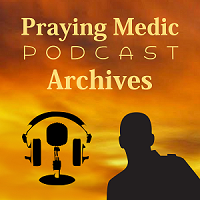Praying Medic's Blog, page 99
February 26, 2016
Today’s Links
Is It God or Is It Me? One of the most common questions I’ve been asked about receiving revelation from God is: “How do I know if a message I’ve received is from God, my soul, or the enemy?” For the purposes of this discussion, it might be easier to separate revelation into two types: […]
The post Today’s Links appeared first on Praying Medic.
Is It God or Is It Me?
One of the most common questions I’ve been asked about receiving revelation from God is: “How do I know if a message I’ve received is from God, my soul, or the enemy?” For the purposes of this discussion, it might be easier to separate revelation into two types: that which is internal (that which comes […]
The post Is It God or Is It Me? appeared first on Praying Medic.
February 25, 2016
Today’s Links
Podcast 044: Matthew Robert Payne – The Writer’s Life To open in another window click this link: podcast 044 I talked with my mate Matthew Robert Payne for a couple of hours about writing books on the kingdom of God. This is an intimate conversation about our passion for Jesus and our love of writing […]
The post Today’s Links appeared first on Praying Medic.
February 22, 2016
Podcast 044: Matthew Robert Payne – The Writer’s Life
To open in another window click this link: podcast 044 I talked with my mate Matthew Robert Payne for a couple of hours about writing books on the kingdom of God. This is an intimate conversation about our passion for Jesus and our love of writing books. Resources Matthew’s Amazon Page My Radical Encounters With […]
The post Podcast 044: Matthew Robert Payne – The Writer’s Life appeared first on Praying Medic.
February 16, 2016
It’s time for an upgrade!
My website will be going through some much needed changes this week. I’ll be installing a new theme which will add a few new features including a much better experience for mobile device users. The redesign will begin Wednesday. I hope to have the changes completed by Friday.
During that time the website will be in “maintenance mode” and posts will be temporarily unavailable. When the new design has been installed and tested, I’ll have a new landing page. On it will be an explanation of the new layout and how to navigate it.
Thank you for your patience and understanding as I work to make your experience better.
~ PM

The post It’s time for an upgrade! appeared first on Praying Medic.
February 15, 2016
Podcast 043: Partnering With God and Traveling in the Spirit
To open in a new window click this link: podcast 043
My pal Shae Bynes is back! In the first part of this message we discuss how I partner with God as an author. In the second part, we discuss traveling in the spirit.
Listen or Subscribe:
The post Podcast 043: Partnering With God and Traveling in the Spirit appeared first on Praying Medic.
February 13, 2016
The Bride on the Inside – Kim Newman
My guest blogger today is my friend Kim Newman. This message was originally shared on Facebook here.
Last night I had repetitive dreams that I was marrying my Husband again, so I took note. Sometimes during dreams, you just become “aware” to pay attention.
I was excited and in a beautiful wedding gown anticipating the special day ahead. I was so happy! I decided to get freshened up a bit more before the nuptials, and thought maybe I would even try on another gown, in case there was one prettier. (Though this was not a thought previously until I started to dwell on it). At that moment, Husband walked out of the brides room where I was about to enter.
I screamed “Look away!!” “You can’t see me!!” And he covered his face??
I was rather impressed that he heed my warning immediately as he is not in the habit of complying so readily in real life to my “suggestions”. Okay. “Commands”.
I walked into the dressing room, but quickly became discontent and started to mess with my hair and veil. But it only made things get worse not better. In fact, my vision started to become blurry and I couldnt see my reflection clearly. It was muddled and hazy. Like a cameras lens that is out of focus. I started to feel panicked!
Isn’t it just like a girl to not leave well enough alone, and insist that the more fussing the better? Ug! But Husband was on the other side of the door, knowing my self sabatoge and scrutiny was taking place. He kept saying “Please don’t do this! Don’t touch a thing! You are beautiful just the way you are.”
Ahhh. God bless the lil’ liar.❤
But I ignore that voice, and I keep trying. I had already convinced myself I was no longer good enough. Ready enough. Or worthy enough. Though the truth is, Husband ALREADY found me worthy to be loved before he ever saw me in my gown at all. He ALREADY loved me just the way I was. But to me, that was only believable BEFORE I looked in the mirror in search of perfection and in search of FINDING every flaw. Whether real or imagined. I looked to the outer. Equating my inner being as worthy only if my outer appeared acceptable.
Backwards.
And then in my dream, I had an “Ah Ha!” moment. I remembered that Husband ALREADY loved me. That He STILL chose me to be His bride. That I was worthy, regardless of my skewed reflection in the mirror.
So I began to take off piece by piece of the outer accessories. I removed the “veil” that covered the true me and hid my face. I removed the bling, that I had thought was where my true sparkle came from, seeing instead it seemed to only compete for the eyes attention and not the hearts. And as I began to strip down each of these outer things, my reflection in the mirrors haze, began to become clearer and clearer. Back into focus. And strangely enough, more vibrant than before, when hiding underneath all the layers.
And there I was. Standing before myself, completely stripped of these layers, except for the simple white wedding dress that accentuated, and not distracted. No jewelry. No shoes. No accessories. No fancy headpiece or perfectly coiffed hair. It was just me. Hair down. Jewels stripped. Unpainted face. A blank white canvas. The kind you see right before the Artist begins painting its story.
And I didn’t care. So I smiled at my reflection. I was a bride ready to be with her bridegroom. And I was worthy. A clean slate. Trusting the Master Artist for the strokes that would bring the true beauty and scene of my life to the canvas. All I needed to keep my eyes on, was not myself. But the Love that was on the other side of the door, waiting for me to join Him.
Just as I am.
And there’s just something to that, I know. ❤
~~~~~~~~~~~~~~~~~~~~~~~~~~~~~~~~
“For YOU, O God, created my inmost being; YOU knit me together in the womb. I praise You because I AM, fearfully and wonderfully made! Your works are wonderful, I KNOW that full well. I was never hidden from you when I was made in that secret place. When You wove me together, Your eyes already saw me! ALL the days You ordained for me, were written in Your book, BEFORE even one came to be! How precious to me are YOUR thoughts! YOUR purpose! YOUR plans for my life. And YOUR beauty You paint on the canvas within it. I am My Beloveds. And My Beloved is mine. And that is everything.”
(Psalm 139 paraphrased)
The post The Bride on the Inside – Kim Newman appeared first on Praying Medic.
February 8, 2016
Podcast 042: Facebook Friends and the Sid Roth Show
To open in a new window click this link: podcast 042
A humorous look at our gathering with Facebook friends during our trip to North Carolina to tape an episode of It’s Supernatural with Sid Roth.

Resources

Listen or Subscribe
Past Episodes
The post Podcast 042: Facebook Friends and the Sid Roth Show appeared first on Praying Medic.
January 29, 2016
Does Matthew 10:8 Prohibit Christians From Charging for Their Service?
 One day my wife finally dropped the bombshell on me. She said she believed I had the talent and calling from God to leave my career as a paramedic and become an author.
One day my wife finally dropped the bombshell on me. She said she believed I had the talent and calling from God to leave my career as a paramedic and become an author.
For years I resisted the urging of friends and relatives who felt I was called to be a writer. I rejected the possibility of writing and selling books because I knew Jesus told His disciples, “Freely you have received; freely give…” and I understood that as a prohibition against selling anything related to God. I could not in good conscience sell a book that was based on the revelation He had given me. My wife suggested I read those instructions again.
The tenth chapters of Matthew and Luke are a great help in understanding the things Jesus expected of His disciples. In Matthew 10, He instructed the twelve about their ministry, and in Luke 10, He gave instructions to the 70. It’s in Matthew chapter 10 that we find the instruction about giving freely. Immediately after choosing the twelve disciples, Jesus gave them power to heal sickness and disease and said to them:
Heal the sick, cleanse the lepers, raise the dead, cast out demons. Freely you have received, freely give. (Mt 10:8 NKJV)
What’s important to note is the context of this verse. The instruction to give freely was not a general instruction that applied to all of their activities. (This becomes clear in the next verse.) It seems as though it applied to healing the sick, casting out demons, cleansing lepers and raising the dead. He did allow them to receive compensation for other things related to their ministry. The next verse reads:
Provide neither gold nor silver nor copper in your money belts, nor bag for your journey, nor two tunics, nor sandals, nor staffs; for a worker is worthy of his food. (verses 9-10)
Jesus sent the disciples out penniless. Rather than telling them to take money to pay for their own needs, they were to rely on the generosity of strangers. They lived in the homes of whoever received them and taught about the kingdom of God. In return, the homeowners provided for their needs. When He sent out the 70, (recorded in Luke chapter 10) He gave them similar instructions, once again telling them not to take any valuables. They were to stay wherever they were welcomed, heal the sick, teach on the kingdom of God and allow strangers to provide for their needs—reminding them that they were laborers for God and that they were worthy of the wages they received. In his letter to Timothy, Paul affirmed that teaching a preaching ought to be compensated:
Elders who do their work well should be respected and paid well, especially those who work hard at both preaching and teaching. For the Scripture says, “You must not muzzle an ox to keep it from eating as it treads out the grain.” And in another place, “Those who work deserve their pay!” (1 Tim. 5:17-18 NLT)
It’s clear from these passages that believers may be compensated for their ministry to the body of Christ. Here’s how I apply these instructions in my own life:
I’ve never asked for money to pray for anyone to be healed, set free of a demon, raised from the dead, or for any type of prayer request. It takes an enormous amount of time to create blog posts, podcasts and videos, but I make these things available for free. I do however, charge for my books, and there are a couple of reasons why:
A typical print book requires me to pay about $1,500 just for editing services. All my books are published through Amazon who sets a minimum price an author must charge for a print book. They don’t allow them to be made available for free. As much as I would like to offer my books for free, it’s just not possible.
Although I once thought it was against the instructions of Jesus to charge for anything related to my service to God, I now understand that there are things that I should offer for free and things for which I may charge. I don’t think this is an unreasonable approach and I believe it’s consistent with way Jesus intended new covenant ministry to be conducted.
The post Does Matthew 10:8 Prohibit Christians From Charging for Their Service? appeared first on Praying Medic.
January 26, 2016
The Gift of Tongues
One of the most controversial spiritual gifts mentioned in the New Testament is the gift of speaking in tongues. Although many people have rejected the idea that God speaks to and through us in this way, I’ve found that there is great benefit to those who practice this gift. The language we speak when we operate in this gift allows us to communicate directly with God. The Holy Spirit enables us to speak a language (or several of them) without ever having to learn them.
Researchers at the University of Pennsylvania recorded scans of the brains of people while they spoke in tongues. The study was published in The New York Times. Dr. Andrew Newberg, who headed the study, concluded:
We noticed a number of changes that occurred functionally in the brain. Our finding of decreased activity in the frontal lobes during the practice of speaking in tongues is fascinating because these subjects truly believe that the spirit of God is moving through them and controlling them to speak… Our brain-imaging research shows us that these subjects are not in control of the usual language centers during this activity, which is consistent with their description of a lack of intentional control while speaking in tongues.
The gift of tongues is not only for a select few. Paul said that he wanted every believer to speak in tongues and prophesy:
“I wish you all spoke with tongues, but even more that you prophesied” (1 Cor. 14:5)
The Bible says that those who speak in tongues are (generally) speaking directly to God:
“For anyone who speaks in a tongue does not speak to men but to God. Indeed, no one understands him; he utters mysteries with his spirit.” (1 Cor. 14:2)
One of the exceptions is when we speak in tongues to declare the wonders of God to others:
“We hear them declaring the wonders of God in our own tongues!” (Acts 2:11)
Or when praising God:
“For they heard them speaking in tongues and praising God.” (Acts 10:46)
Those who are experienced with speaking in tongues report that their spirit is strengthened the more they pray in tongues. It also seems to open up a clearer channel of communication between them and God. The gift of speaking in tongues is the one gift given to edify (strengthen) the individual. The rest of the gifts of the Holy Spirit are given to strengthen the body of Christ:
“He who speaks in a tongue edifies himself, but he who prophesies edifies the church.” (1 Cor. 14:4)
When I pray with people for healing or deliverance, my wife often prays alongside me. I begin by praying in English as I’m led by the Spirit—most often through visions. She rarely prays in her native language, which is English, but prays as she is led by the Spirit in tongues. She’s become so accustomed to praying in tongues that today it’s easier for her to pray in tongues than it is to pray in English.
The gift of speaking in tongues is like any other gift. The more we exercise it, the more proficient we’ll become at it. If you desire to operate in the gift of tongues, pray for it and believe that you will receive it. Speaking in tongues is not something the Holy Spirit does to you. It is rather, a way that He operates through you as you speak or pray. The key is that you must initiate the process.
When I first began speaking in tongues, I heard in my mind words that were softly spoken in a language I had never heard before. As I’ve said in other chapters, one way in which you can know revelation is from God is when it sounds unlike anything you would normally think. The words I heard in my mind were completely foreign to me. I assumed they were the words the Holy Spirit wanted me to speak, so I said them to the best of my ability. The apostle Paul said that the main problem with speaking in tongues is that our natural mind doesn’t understand what we say:
“For if I pray in a tongue, my spirit prays, but my understanding is unfruitful.” (1 Cor. 14:14)
There are times when it isn’t necessary to know what we are praying. Paul discussed this in the eighth chapter of Romans:
“Likewise the Spirit also helps in our weaknesses. For we do not know what we should pray for as we ought, but the Spirit Himself makes intercession for us with groanings which cannot be uttered. Now He who searches the hearts knows what the mind of the Spirit is, because He makes intercession for the saints according to the will of God.” (Rom. 8:26-27)
Praying in tongues is a way in which the Spirit of God can inspire our prayer when we aren’t sure how we ought to pray. The Holy Spirit is our helper, our comforter, our intercessor, and faithful friend. Praying in tongues empowers us when we are weak, comforts us when we are sad, and through it, He intercedes for us according to His perfect will.
This is an excerpt from my book Hearing God’s Voice Made Simple. Click on the link or on the image below to check out the book.
The post The Gift of Tongues appeared first on Praying Medic.








